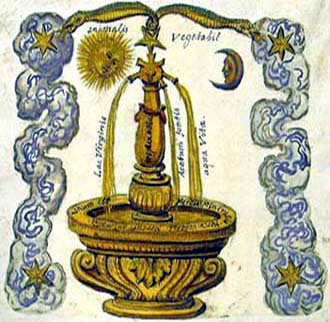Carl Jung and the Rosarium Philosophorum

The Rosarium Philosophorum is a sixteenth century alchemical treatise, with a series of twenty woodcuts.
Jung’s comments on the first image, the image with the fountain, include the following:
This fluid substance, with all its paradoxical qualities, really signifies the unconscious which as been projected on to it.
The “sea” is its static condition, the “fountain” its activation, and the “process” its transformation….
The circular sea with no outlet, which perpetually replenishes itself by a spring bubbling up from its center, is to be found in Nicolas de Cusa as an allegory of God.
The Psychology of the Transference
Collected Works 16
Paragraphs 408-409
(Jung goes over many of the images in the Rosaruium at length; wading through the Psychology of the Transference is well worth the effort.)
For more commentary, see Adam McLean:
A Commentary on the Rosarium philosophorum – Adam McLean
